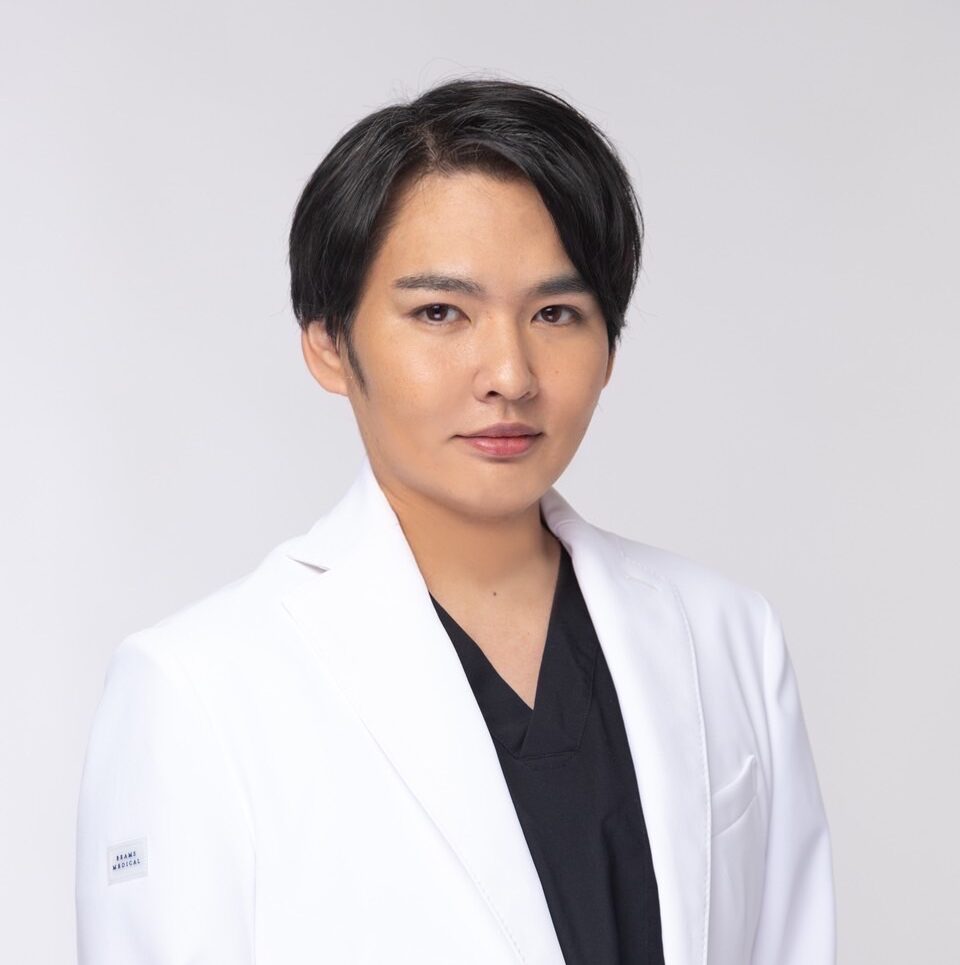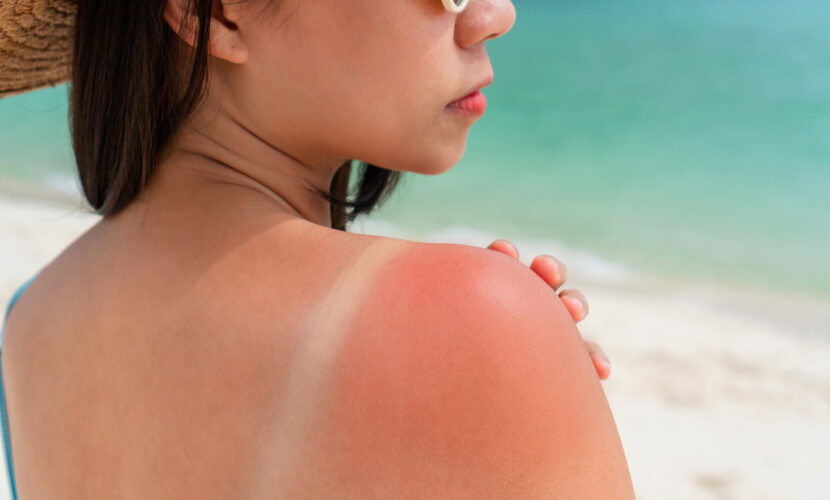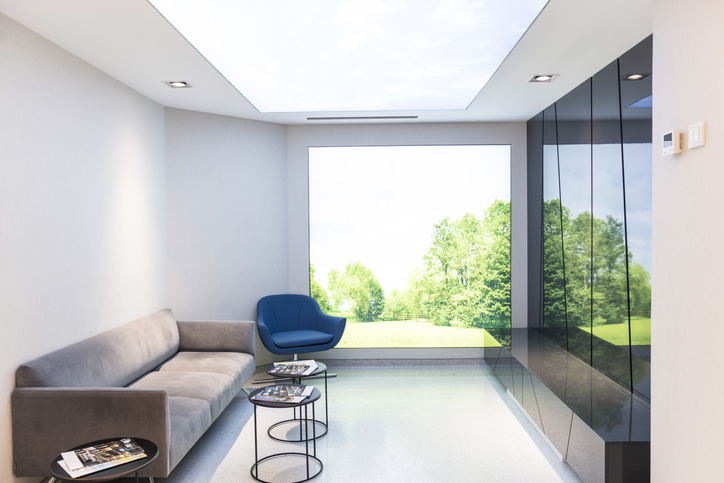夏の日差しが強くなると、紫外線による肌へのダメージが気になります。日焼けは一見健康的に見えるかもしれませんが、実際にはシミやそばかす、さらには皮膚がんのリスクを高める原因となります。特に夏の紫外線は強烈で、適切な対策を怠ると後々の肌トラブルに繋がる可能性が高まります。
ここでは、夏の日焼け対策の重要性とその方法について詳しく解説します。海やプール、ゴルフなどアウトドア活動が増えるこの季節を楽しむために、しっかりとした日焼け対策を行いましょう。

国立熊本大学医学部を卒業。国内大手美容クリニックなどで院長を歴任し、2023年アラジン美容クリニックを開院。長年の実績とエイジングケア研究で博士号取得の美容医療のプロ。「嘘のない美容医療の実現へ」をモットーに、患者様とともに「オンリーワン」を目指す。
夏の日焼けのメカニズムとその影響

夏になると強くなる紫外線は、肌にさまざまな影響を与えます。紫外線には主にUVAとUVBの2種類があり、それぞれ異なる特性と影響を持っています。これらの違いを理解することは、適切な日焼け対策を行うために重要です。
まず、UVA(長波長紫外線)について説明します。UVAは紫外線の約95%を占め、地表に届く紫外線の大部分を構成しています。この紫外線は一年中、季節や天候に関係なく地表に降り注ぎます。UVAの波長は長く、肌の奥深くにまで到達し、真皮層にまで影響を与えることができます。これにより、コラーゲンやエラスチンを破壊し、肌の弾力を低下させるため、シワやたるみの原因となります。さらに、UVAはメラニン色素を酸化させ、即時に肌を黒くすることもあります。
一方、UVB(中波長紫外線)は全紫外線の約5%程度ですが、そのエネルギーは非常に強力です。UVBは肌の表皮に影響を与え、日焼けを引き起こします。特に夏の間は地表に届く量が増加し、短時間で肌にダメージを与えることが多いです。UVBによる日焼けは、肌が赤くなり、ひりひりとした痛みを伴う急性の反応が一般的です。また、長期的にはシミやそばかす、さらには皮膚がんのリスクを高めることもあります。
これらの紫外線は、日常生活で避けることが難しいため、適切な対策が求められます。UVAとUVBの両方から肌を守るためには、日焼け止めの使用や物理的な防御方法が有効です。特に夏場は紫外線の影響が強くなるため、しっかりとした対策を行うことが、美しい肌を保つためには欠かせません。
日焼けの原因となるメラニン生成のプロセス
日焼けがどのようにして起こるか、そのメカニズムを理解することは、効果的な日焼け対策を取るために重要です。日焼けは、主に肌が紫外線から自身を守るために行う自然な防御反応です。
紫外線が肌に当たると、肌の細胞にダメージが生じます。これに対して、肌はメラニンと呼ばれる色素を生成して、細胞を保護します。メラニンはメラノサイトという細胞で生成され、紫外線を吸収して無害化する役割を果たします。以下がメラニン生成のプロセスです:
- 紫外線の照射
紫外線が肌に当たると、肌の細胞にダメージが生じます。この刺激により、メラノサイトが活性化されます。 - メラノサイトの活性化
メラノサイトが活性化されると、メラニン生成が始まります。メラニンはチロシナーゼという酵素によって作られ、紫外線を吸収して肌の細胞を保護します。 - メラニンの分布
生成されたメラニンは、ケラチノサイトという細胞に取り込まれ、肌の表面に分布します。これにより、肌が黒くなる現象が日焼けとして現れます。
このメラニン生成は、肌を紫外線から保護するための自然な防御機構ですが、過剰な紫外線曝露は肌の健康に悪影響を及ぼします。長時間の紫外線曝露は、メラニン生成を過剰に刺激し、シミやそばかすを引き起こすだけでなく、皮膚がんのリスクを高めることもあります。
日焼け止めの選び方
日焼け止めを選ぶ際には、SPF(Sun Protection Factor)とPA(Protection Grade of UVA)の表示を確認することが重要です。SPFは主にUVBに対する防御効果を示し、数値が高いほどUVBから肌を守る効果が強くなります。一般的に、日常生活ではSPF30程度が推奨されますが、長時間の屋外活動や強い日差しを浴びる場合にはSPF50を選ぶと良いでしょう。
PAはUVAに対する防御効果を示し、PA+からPA++++までの4段階があります。+が多いほど防御効果が高くなります。UVAは肌の奥深くまで届き、シワやたるみの原因となるため、PAの高い日焼け止めを選ぶことが重要です。
正しい塗り方と頻度
日焼け止めは、外出する15〜30分前に塗るのが効果的です。顔や首などの露出部分には、均一にたっぷりと塗布します。特に鼻や頬、耳の裏など、日焼けしやすい部位には忘れずに塗りましょう。体に塗る場合も、肩や腕、脚などの露出部分にしっかりと塗ります。
また、日焼け止めは汗や水で落ちやすいため、2〜3時間おきに塗り直すことが推奨されます。特に海やプールでは、水に濡れた後やタオルで拭いた後には必ず塗り直すようにしましょう。
物理的な紫外線の防御も
日焼け止めと併用して、物理的な防御方法を取り入れることも効果的です。広いつばのある帽子をかぶることで、顔や首の紫外線を防ぐことができます。サングラスは目の周りのデリケートな肌を守るだけでなく、紫外線による目のダメージも防ぎます。長袖の衣服や長ズボンは、直接肌が紫外線に晒されるのを防ぐため効果的です。
特に日傘は手軽に持ち運べる紫外線対策アイテムとして人気です。特にUVカット加工が施された日傘は、高い防御効果を発揮します。屋外では、サンシェードを利用して日陰を作り、直接紫外線を浴びるのを避けることも有効です。
アウトドアの増える夏!場所別の日焼け対策

夏になるとアウトドア活動が増え、紫外線にさらされる機会も多くなります。海やプール、ゴルフやランニングなど、シーンに応じた日焼け対策をしっかりと行うことが重要です。ここでは、場所別の日焼け対策について詳しく解説します。
海やプールでの日焼け対策
海やプールでは、水に濡れることが多いため、ウォータープルーフの日焼け止めを使用することが重要です。ウォータープルーフの日焼け止めは、水に強く、長時間効果を保つことができます。ただし、完全に防水ではないため、泳いだ後やタオルで拭いた後には、必ず塗り直すことが推奨されます。
また、ラッシュガードは、紫外線を防ぐための効果的なアイテムです。肌をしっかりと覆うことで、直接紫外線が肌に当たるのを防ぎます。最近のラッシュガードにはUVカットの製品も多数ありますので、より効果が期待できます。
さらにスイムキャップも頭皮の日焼けを防ぐために有効です。特に髪の薄い部分や、日焼けしやすい耳の周りなどを保護することができます。スイムキャップでなくともビーチハットなどを使うと安心でしょう。
ゴルフやランニング中の対策
ゴルフやランニングなどのスポーツをする際には、手軽に使える日焼け止めスプレーが便利です。スプレータイプの日焼け止めは、汗をかいてもべたつかず、すばやく乾くため、運動中の使用に適しています。また、広い範囲に均一に塗布できるため、短時間で効果的な紫外線対策が可能です。
長時間の屋外活動では、アームカバーや首用のガードを使用することも有効です。アームカバーは、腕全体を覆うことで紫外線から肌を守ります。また、首用のガードは、首の後ろやデコルテ部分の日焼けを防ぐために効果的です。これらのアイテムは、通気性が良く、涼しさを保ちながら紫外線を遮断する設計になっているものを選ぶと良いでしょう。
インドア派は大丈夫?インドアの日焼け対策
日焼け対策といえば屋外でのケアが主に注目されますが、実は室内でも紫外線の影響を受けることがあります。インドア派の方でも、しっかりと紫外線対策を行うことが重要です。
実際には窓ガラスを通してUVAが室内に入り込み、肌にダメージを与えることがあります。特に、日当たりの良い部屋で長時間過ごす場合や、窓の近くにいることが多い場合には、紫外線対策が必要です。たとえば窓ガラスにUVカットフィルムを貼ることで、室内に入る紫外線の量を大幅に減らすことができます。UVカットフィルムは、紫外線を遮断するだけでなく、部屋の温度を下げる効果もあるため、夏場のエアコン代節約にも役立ちます。
また、日中はカーテンやブラインドを閉めることで、紫外線の侵入を防ぐことができます。特にUVカット効果のあるカーテンを使用することで、さらに効果的に紫外線対策を行うことができます。
日焼け後のケアも忘れずに!夏の日焼け対策

日焼けをしてしまった後のケアは、肌の健康を保つために非常に重要です。適切なスキンケアと回復方法を取り入れることで、日焼けによるダメージを最小限に抑え、肌の回復を促進することができます。ここでは、日焼け後の効果的なケア方法についてみていきます。
日焼け後のスキンケア方法
日焼け後の肌は非常にデリケートで、迅速かつ優しいケアが必要です。まずは、日焼けした肌を冷やすことが重要です。冷水で優しく洗い流すか、冷湿布を使用して肌をクールダウンさせましょう。冷却は炎症を抑え、痛みを和らげる効果があります。
たとえばアロエベラジェルは、日焼け後のスキンケアにおいて非常に効果的です。アロエベラには抗炎症作用と保湿効果があり、肌の回復をサポートします。日焼け後すぐにアロエベラジェルを塗布することで、肌の赤みや痛みを軽減し、保湿を行うことができます。また、冷却シートも便利です。冷却シートを使用することで、持続的に肌を冷やし、炎症を抑えることができます。
肌の回復をより早めたいには?
日焼け後の肌は、栄養と保湿が欠かせません。日焼けによって失われた水分を補うために、保湿クリームやローションをたっぷりと使いましょう。特にヒアルロン酸やセラミドが含まれた製品は、保湿効果が高く、乾燥を防ぐのに役立ちます。
日焼け後の肌は乾燥しやすくなるため、保湿が非常に重要です。保湿クリームやローションを使用して、肌に十分な水分を補給しましょう。また、ビタミンCやビタミンEが含まれた美容液やクリームを使用することで、抗酸化作用を発揮し、肌の回復を促進することができます。内側からの栄養補給も大切です。バランスの取れた食事を心がけ、ビタミンやミネラルを豊富に摂取することで、肌の健康をサポートします。
美白美容液の活用
日焼けによって肌にシミや色素沈着が発生することがあります。このようなトラブルを防ぐためには、美白美容液の使用が効果的です。ビタミンC誘導体やアルブチン、ナイアシンアミドなどの成分が含まれた美容液を使用することで、メラニン生成を抑制し、肌のトーンを均一に保つことができます。美白美容液は、日焼け後のケアとして取り入れることで、肌の明るさを保ちながら健康的な状態を維持することができます。
夏バテにも効果的!食事と日焼け対策の関係

日焼け対策は、外からのケアだけでなく、内側からのアプローチも重要です。食事によって取り入れる栄養素が、肌の健康や紫外線ダメージの回復をサポートします。
抗酸化作用のある食品やサプリメント
| 栄養素 | 効果 | 含まれる食品 |
|---|---|---|
| ビタミンC | 抗酸化作用、紫外線ダメージの軽減 | 柑橘類(オレンジ、レモン、グレープフルーツ)、いちご、キウイ、パプリカ |
| ビタミンE | 抗酸化作用、細胞膜の保護 | アーモンド、ヘーゼルナッツ、ひまわりの種、アボカド |
| カロテノイド | プロビタミンAとして働き、紫外線ダメージから肌を保護 | にんじん、かぼちゃ、トマト、ほうれん草 |
| リコピン | 強力な抗酸化作用、紫外線からの保護 | トマトなど |
日焼け対策には、外からのケアだけでなく、内側からのアプローチも非常に重要です。食事によって取り入れる栄養素が、肌の健康や紫外線ダメージの回復をサポートします。ここでは、抗酸化作用のある食品やサプリメント、美白効果のある成分について詳しく解説します。
抗酸化作用のある食品を積極的に摂取することは、紫外線による酸化ストレスを軽減するために効果的です。まず、ビタミンCは強力な抗酸化作用を持ち、紫外線によるダメージを軽減する効果があります。柑橘類(オレンジ、レモン、グレープフルーツ)や、いちご、キウイ、パプリカなどに豊富に含まれており、日常的にこれらの食品を摂取することで、肌の健康をサポートできます。また、ビタミンCのサプリメントを活用するのも一つの方法です。
次に、ビタミンEも優れた抗酸化作用を持ち、肌の保護に役立ちます。アーモンドやヘーゼルナッツ、ひまわりの種、アボカドなどに多く含まれています。これらの食品をスナックとして取り入れることで、手軽にビタミンEを補給できます。ビタミンEは、紫外線によるフリーラジカルの生成を抑え、細胞膜を保護する効果があります。
さらに、カロテノイドはプロビタミンAとして働き、紫外線によるダメージから肌を守ります。にんじん、かぼちゃ、トマト、ほうれん草などの色の濃い野菜に多く含まれており、特にトマトにはリコピンという強力な抗酸化物質が含まれています。リコピンは紫外線から肌を保護し、日焼け対策には欠かせない成分です。
これらの抗酸化作用のある食品やサプリメントを積極的に取り入れることで、内側から紫外線ダメージを防ぎ、肌の健康を維持することができます。また、これに加えて美白効果のある成分を含む食品を摂取することで、日焼け後のシミや色素沈着を防ぎ、明るく健康的な肌を保つことができます。
食事から取り入れる美白効果のある成分
紫外線を浴びた後の肌のケアとして、美白効果のある成分を含む食品を積極的に摂取することも重要です。前述したビタミンC以外にビタミンB群も重要な栄養素です。ビタミンB群は、細胞の代謝を促進し、肌の再生をサポートします。特にビタミンB3(ナイアシン)は美白効果があるとされ、肌のトーンを均一に保つのに役立ちます。鶏肉、魚、卵、豆類などに豊富に含まれています。これらの食品をバランスよく摂取することで、日焼け後の肌の回復を促進することができます。
また、ポリフェノールはメラニン生成を抑制する作用があり、美白効果が期待できます。緑茶、赤ワイン、ブルーベリー、ダークチョコレートなどに含まれており、これらを摂取することで、日焼けによる色素沈着を防ぐことができます。ポリフェノールを含む食品を日常的に取り入れることで、肌の健康を維持し、内側からの美白対策を強化できます。
このように、栄養素を意識した食品を積極的に摂取することで、日焼け後のダメージを内側からケアし、美しい肌を保つことができます。ただし過剰摂取などには気を付けながらバランスのよい食事で日焼け対策を取り入れると健康的な肌を維持に効果的でしょう。
まとめ
夏の日焼け対策は、美しい肌を守るために欠かせません。紫外線によるダメージを防ぐために、適切な日焼け止めの選び方や使い方、物理的な防御方法を実践しましょう。また、日焼け後のケアや食事によるサポートも大切です。
今回紹介したポイントを取り入れて、肌トラブルを防ぎながら夏を楽しんでください。健康的で美しい肌を保つために、日々のケアを怠らず、夏のアクティビティを思いっきり楽しんでください。
アラジン美容クリニックでは、美容医療および美容皮膚における長年の経験や博士号を持つ知見より、出逢う皆様のお一人ひとりに最適な施術を提供する「オンリーワン」を目指すカウンセリングを実施し、余計な情報や提案をせず、「ウソのない」美容医療で、必要な施術のみをご提案しております。
LINE公式アカウントにて、お気軽に24時間カウンセリングや予約を受付しております。無料カウンセリングで初めての方やお悩みの方はぜひ一度ご相談くださいませ。






